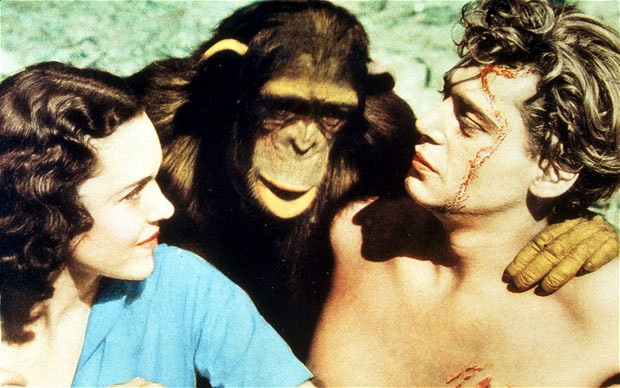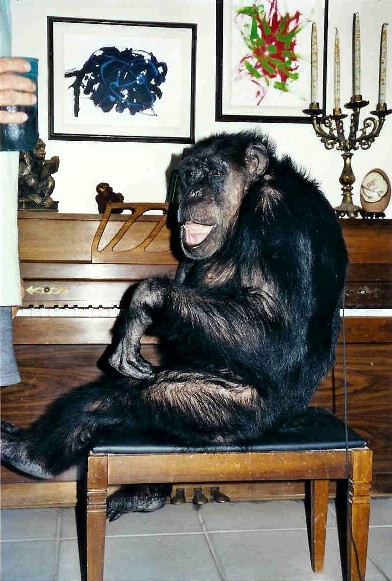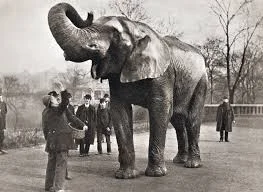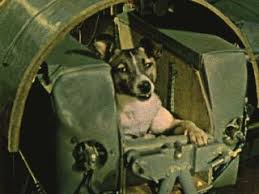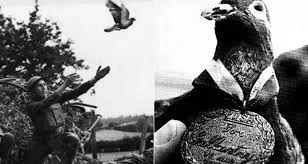By The Landlord
"Some people talk to animals. Not many listen though. That's the problem." – A.A. Milne
"A movie star is not quite a human being." – Marlene Dietrich
"Dietrich … I doubt very much that you're human." – Cheeta
"Woof!" – Lassie
I've been lucky enough to have met a few famous people in my life, mostly through work – pop stars, film stars, artists, and politicians, but the biggest fan frenzy I've ever seen was when Uggie, the Jack Russell who played Jack, Valentin's dog in the Oscar-winning 2011 French silent film The Artist, came to the office. It was as if Brad Pitt had arrived in a giant chocolate fountain. People were falling over each other, nay rolling over and having their tummies tickled, just to catch a glimpse of him, and even better pet the lovely little fellow, just like screaming fans of the Beatles. "Oh! But he's so cute and clever ...!"
Famous animals. We love them. But why? Because they are a little bit like us, but in the best way, not the worst. They carry or focus our emotions. They are the objects of great fondness. They do something to enhance our lives. They communicate with us in a way that is honest, and child-like, but athletic and strong, loyal, true to the heart. Even if they are fierce and deadly, like Jaws, or Aslan, they never seem phoney. They represent the better side of us, a noble form of anthropomorphism. So If it's not Uggie rescuing his owner from a fire, or stopping him from shooting himself, it's Lassie rescuing Timmy, or another boy from the bottom of a well. Or it could be real-life heroes of war or key historical events, such as Paul Revere's mare, Brown Beauty, made famous by the Longfellow poem The Midnight Ride.
For, borne on the night-wind of the Past,
Through all our history, to the last,
In the hour of darkness and peril and need,
The people will waken and listen to hear
The hurrying hoof-beats of that steed,
And the midnight message of Paul Revere.
So this week our theme is famous or specific animals. That category, like legendary events, as well as animal movie stars, covers both the factual and fictional. After all, there was more than one dog playing Lassie, the character created by Eric Knight, all of whom had different names.
Lassie Come Home
The dog named Pal was the original in Lassie Come Home, then in the TV series the character was played by her son, Lassie Junior. Yet the more we consider it, the idea of a name is a strange concept with animals (how do we know?) and yet they often respond to that particular sound. But name-giving makes that animal specific for human purposes, so this week the animal has to be a certain individual, not simply a song about 'my dog' or 'my horse'. So for songs, one way in is to search for specific animals’ names, referred to in lyrics, either in passing, or preferably as the key focus of a song.
Animal film and TV stars, from Lassie to Skippy The Bush Kangaroo, to Flipper the Dolphin, of course inhabit a world of illusion, a blurred line between fact and fiction, but behind them is a talented animal that, via owner and trainer, has learned to engage at a high level with humans, beyond the usual fetch-a-ball level, into impressive highly functioning communication and work, and no shortage of love. While many animals are cute and lovable, the character of Cheeta, the cheeky chimp of the early Tarzan films starring Johnny Weissmuller, gained a new dimension in the last few years. It's unlikely that the apparent septuagenarian cigar-smoking, drinking Cheeta (aka Jiggs IV), who painted "ape-stract" art, and shared a joint 70th birthday 2002 London exhibition withSgt Pepper album cover creator and artist Peter Blake, really starred in the early Tarzan movies before all the other stand-ins. It's more likely he began working in TV the 1960s. But Cheeta's profile has extended into a brilliant book, ghostwritten by James Lever, full of bitchy, hilarious anecdotes that can't be sued by the dead film stars within it, as well as skilfully mentioning, with an arch irony, all the animal mistreatment that went behind the scenes. The book is a brilliant piece of satire, lambasting the industry, full of affection for Weissmuller, but filled with fabulous stories witnessing stars getting drunk, having sex with each other, as if they are the real animals. Here's a sample of his wit and humour:
'Maureen was in reality highly imitable. I myself can do a reasonable "Maureen O'Hara" simply by screeching as loud as I can and flinging my excrement around.'
An elderly Cheeta at the piano, with his ‘ape-stract’ art on the wall
There are so many other TV and film animal stars that may come up in song lyrics. Rin Tin Tin and Strongheart (White Fang) the German Shepherds, Trigger the horse, or indeed Bamboo Harvester as stable Mister Ed, Orangey the cat, Bart the bear, Hedwig the snowy owl from Harry Potter played by Gizmo, or the monkeys Rancho or Crystal. Real names, fictional names – they all count as both are as meaningful as they are meaningless. It's what the animals do, represent and mean to us, that count.
Some animals sit in a political context. How about Larry the famous Downing Street Cat who fights with the one next door, or Socks, the White House counterpart?
Larry the Cat, at 10 Downing Street. He’s seen a few rats scurrying about …
Racehorses have almost certainly have inspired many songs. Arkle? Shergar? Red Rum? Perhaps Desert Orchid, or from further back Eclipse, Phar Lap, Flying Fox, Seabiscuit? Here's a sample. Russell Morris's Big Red. This won't spoil the race this week because it was already expertly chosen for the previous topic of autobiographical and biographical songs.
Some animals, notably big cats, have become famous from documentaries and books. Elsa the lioness draw worldwide attention from Born Free, by naturalist Joy Adamson. And Christian the lion, born in captivity and purchased by Australian John Rendall and Anthony "Ace" Bourke from Harrods department store in London in 1969, eventually released into the wild and subject of a moving reunion.
While some animals were exploited or enjoyed their time on the racetrack, others gained popularity by performing in other arenas. Going way back, Marocco the Dancing Horse was very famous in England in 1591, and immortalised by Shakespeare in Love’s Labours Lost. He was known to His count coins by stamping his hoof, dance on on four to even two legs, and bowing to the Queen. He was also thought to be psychic, because he moved his legs in reply to certain questions. But his owner and he, William Bankes were tried for witchcraft, found guilty and condemned to death. The The judge was apparently moved when the horse knelt in front of him to plead for his owner’s life, however, and both were pardoned. The stuff of legend or fact? Either way a fabulous story.
Bigger than Shakespeare: Marocco the famous horse of Elizabethan era.
Many performing beasts of fame and fortune don’t have quite the same happy ending. The original original Jumbo the elephant was a huge animal from Africa, taken from French Sudan to the Jardin des Plantes zoo in Paris then to again to the London Zoo. He became difficult to control, was sold to P.T. Barnum for £10,000, and forced to perform. Jumbo was so popular by zoo visitors, Queen Victoria received over 100,000 letters pleading for her intervention in the matter, and yet by all accounts he became calmer, and more used to living in Barnum’s circus with something to do. Yet it didn’t end well, dying from injuries result of a train crash three years later.
The original Jumbo
Again fact and fiction intertwine with all famous animal stories, often with tragedy covered over by alleged triumph. The incredible Russian dog Laika, inspiration to several songs, who went up in Sputnik 2 in 1957 as part of the space race, dead within a few hours of his mission, not several days later, as was portrayed. Four years later, Ham the chimp, the first hominid in space from a Nasa mission, at least made it out after an aborted mission due an oxygen shortage.
Laika
There are many other unsung heroes of the war, science and other frontiers, or even incredible survival Perhaps your suggestions might include Unsinkable Sam the cat, first rescued from the Bismarck on May 27, 1941, swimming to safety and jumping on a plank, while over 2,000 crew died, and the adopted by British sailors, he survived two other major sinkings, HMS Cossack, then the Ark Royal, eventually living in safety at a seaman’s house and dying of old age in 1955.
Some animals have gained fame just by living. For a long time. Is Jonathan the Seychelles tortoise the oldest living animal? It’s quite possible that he was born around 1832, and so is around 187 years old. At the other end of the scale is Dolly The Sheep, the first mammal cloned from an adult somatic cell, but only lived until she was seven, but a heroine of science nonetheless.
Dolly the Sheep with the far less famous geneticist Professor Ian Wilmut
Or most unusually, in war heroics, comes the story of Cher Ami the homing pigeon who flew a total of 12 important First World War missions over several months in 1918, and his final journey took place on the afternoon of October 4, 1918 during the Battle of the Argonne. The corps were being shelled by their own men at the time, and Major Whittlesey, the officer in charge, sent Cher Ami off with a little note attached to his leg telling them to stop it. Even though badly wounded in the chest, blinded in one eye, and with one leg hanging off, the little bird managed to carry on, and saved the lives of more than 200 men. He was patched up after his momentous flight and given a wooden leg, and died less a year later.
Cher Ami
So then, it’s time to fly swiftly to another hero, of the human kind, this week’s conductor of animal magic, and guest guru carrying on the message - the fabulous Uncleben. Place your famous animal songs in comments below for deadline on Monday 11pm UK time, and playlists published on Wednesday. Woof! Meow! Howl!
New to comment? It is quick and easy. You just need to login to Disqus once. All is explained in About/FAQs ...
Fancy a turn behind the pumps at The Song Bar? Care to choose a playlist from songs nominated and write something about it? Then feel free to contact The Song Bar here, or try the usual email address. Also please follow us social media: Song Bar Twitter, Song Bar Facebook. Song Bar YouTube. Subscribe, follow and share.

